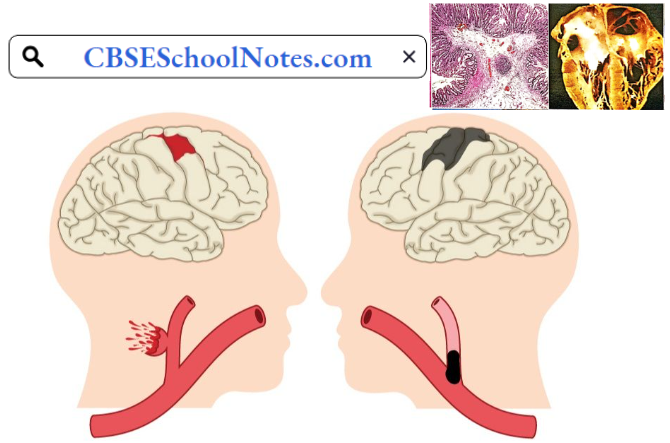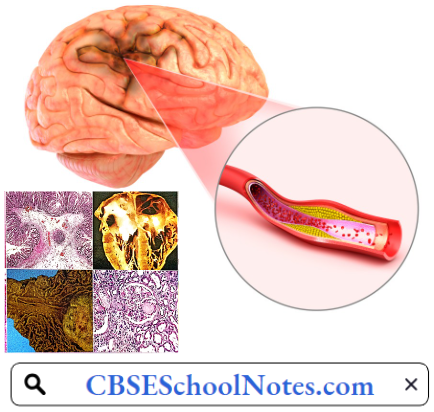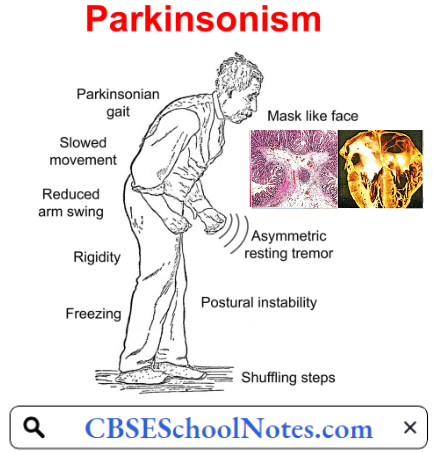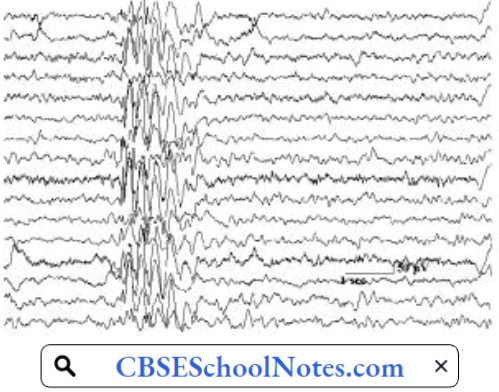Disorders Of Nervous System
Stroke
Stroke is one of the most devastating consequences of two common diseases, atherosclerosis and hypertension. It represents the second leading cause of death (after coronary artery disease) and a major cause of disability worldwide. Besides age, hypertension is the most important cardiovascular risk factor for developing both ischemic and hemorrhagic stroke.
Definition Stroke: The sudden death of some brain cells due to lack of oxygen when the blood flow to the brain is impaired by blockage or rupture of an artery to the brain is known as stroke.
Stroke Causes: There are two types of stroke.
- Ischemic Stroke In a patient with atherosclerosis, a thrombus formation in one of the blood vessels supplying the brain blocks the blood flow to a part of the brain. That area undergoes ischemic necrosis and loss of function.
- In some patients, a blood clot in the heart or a blood vessel becomes loose (called an embolus), travels in the arterial system, and blocks a blood vessel in the brain, resulting in ischemia and necrosis. Ischemic stroke can also occur when a large atherosclerotic plaque clogs the brain’s blood vessels. About 80% of all strokes are ischaemic.
- Hemorrhagic Strokes occur when a blood vessel in the brain ruptures. The result is blood seeping into the brain tissue, causing damage to brain cells. The most common causes of hemorrhagic stroke are high blood pressure and cerebral artery aneurysms. An aneurysm is an abnormal focal dilation of an artery in the brain that results from a weakening of the muscular layer.
Read and Learn More Pathophysiology
Stroke Symptoms: The most common symptoms of a stroke are
- Weakness or numbness of the face, arm, or leg on one side of the body
- Loss of vision in one or both eyes
- Loss of speech, difficulty talking, or understanding what others are saying
- Sudden, severe headache
- Loss of balance or unstable walking

Stroke Signs
- Paralysis: The paralysis affects movements of the face, arm, and leg
- Muscle Tone: Hypertonia (spasticity) is most prominent in the antigravity muscles (flexors of the upper limb and extensors of the lower limb). When a passive flexion of a limb is attempted, initially the examiner feels a lot of resistance. But if the attempt is continued, the resistance suddenly disappears. This phenomenon is called spasticity or clasp-knife effect.
- Deep Reflexes: Knee jerks, ankle jerks, and biceps jerks are exaggerated.
- Superficial Reflexes: Abdominal and plantar reflexes are absent.
- Babinski’s sign is present.
- Sensory Deficit: In patients with more extensive lesions of the internal capsule, the sensory and visual fibers are also affected.
- Recovery: In many patients, a considerable degree of recovery occurs. Muscles of the lower limb and proximal muscles of the upper limb show better recovery of voluntary control than fine muscles of the hands and fingers.

Stroke Pathogenesis
- Ischemic Stroke: Ischemic stroke occurs because of a loss of blood supply to part of the brain. Cerebral ischemia initiates a series of changes called the ischemic cascade. Brain tissue ceases to function if deprived of oxygen for more than 60 to 90 seconds, and after approximately three hours will suffer irreversible injury leading to the death of the tissue, i.e. cerebral infarction.
- Atherosclerosis may disrupt the blood supply by
- Narrowing the lumen of blood vessels leads to a reduction of blood flow, or
- By causing the formation of blood clots within the vessel,
- Embolic infarction occurs when emboli formed elsewhere in the circulatory system, typically in the heart as a consequence of atrial fibrillation, or in the carotid arteries, break off, enter the cerebral circulation, and then lodge in and block brain blood vessels.
- Brain tissue is especially vulnerable to ischemia since it has little respiratory reserve and is completely dependent on aerobic metabolism, unlike most other organs. Since blood vessels in the brain are now blocked, the brain becomes low in energy, and thus it resorts to using anaerobic metabolism within the region of brain tissue affected by ischemia.
- Anaerobic metabolism of glucose can produce adenosine triphosphate (ATP) but releases a by-product called lactic acid. Lactic acid is an irritant that could potentially destroy cells since it is an acid and disrupts the normal acid-base balance in the brain.
- As oxygen or glucose becomes depleted in ischemic brain tissue, the production of ATP fails, leading to the failure of the energy-dependent sodium-potassium pump necessary for tissue cell survival. This sets off a series of interrelated events that result in cellular injury and death.
- Besides the failure of the sodium-potassium pump, another major cause of neuronal injury is the release of the excitatory neurotransmitter glutamate. Glutamate is normally stored within the neurons. During neuronal activity, glutamate is released into the cerebral extracellular fluid (ECF), but its extracellular concentration is immediately decreased by its re-uptake into the neurons.
- The re-uptake process is also dependent on an ATP-dependent sodium-potassium pump. In the deficiency of ATP, glutamate concentration in the cerebral ECF increases. Glutamate produces an influx of calcium into the neurons which activates enzymes that digest the cells’ proteins, lipids, and nuclear material.
- Calcium influx can also lead to the failure of mitochondria, which can lead further toward energy depletion and trigger cell death. Ischemia also induces the production of oxygen free radicals and other reactive oxygen species which are lethal to the neurons.
- Hemorrhagic Strokes: Hemorrhagic stroke constitutes about 10% of total strokes. Hypertension is the major cause of rupture of a cerebral blood vessel. The rupture of an aneurysm in the cerebral artery is another cause. Hemorrhagic strokes result in mechanical tissue injury by causing compression of tissue from an expanding hematoma.
- In addition, the pressure may lead to a loss of blood supply to affected tissue with resulting infarction. The third pathogenic mechanism is the direct toxic effect of blood in the cerebral ECF. Inflammation contributes to the secondary brain injury after hemorrhage.

Stroke Pathophysiology: The changes in the brain described above occur most often in the middle cerebral artery, which supplies the region called the internal capsule. All tire descending motor fibres of the corticospinal tract as well as tire sensory fibers ascending to the sensory cortex pass through the internal capsule.
- Depending on the extent of the lesion in the internal capsule, stroke may result in only motor deficit or motor as well as sensory deficit.
- Moreover, because of the decussation of the corticospinal tract and sensory tract in the medulla, the internal capsule lesion produces motor and sensory effects on the contralateral side. It means, if the lesion is in the left internal capsule, motor and sensory deficits would occur on the right side of the body.
Stroke Risk factors
- High blood pressure
- Cigarette smoking
- High cholesterol
- Diabetes
- Age: People age 55 or older have a higher risk of stroke than younger people
- Sex: Men have a higher risk of stroke than women.

Stroke Complications
- Paralysis or loss of muscle movement may persist permanently
- Difficulty talking or swallowing may persist
- Memory loss or thinking difficulties.
- Emotional problems. The patient may develop depression.
- Pain.
- Bedsores
Parkinson’s Disease
Parkinson’s disease (PD) affects 1% of the population above 60 years of age. It is a long-term degenerative disorder of the central nervous system that mainly affects the motor system. PD usually begins around age 60, but it can start earlier. It is more common in men than in women.
Parkinsons Disease Aetiology: PD is caused by degeneration of dopaminergic neurons in the substantia nigra, one of the basal ganglia. The cause of degeneration is not known.
Parkinson’s Disease Symptoms and Signs
1. Bradykinesia: This term is used to describe the inability to initiate movements. Poverty of movement is the most characteristic feature of Parkinson’s disease. The patient has a mask-like facial expression and an unblinking reptilian stare. There is absence of normal associated movements, for example, swinging of the arms during walking or change of facial expression related to the emotional content of the speech.

Even ordinary motor tasks are performed very slowly, taking much longer time than average normal. Bradykinesia /akinesia are not due to any paralysis. The sensory system is also normal. Still, there is great difficulty in initiating voluntary movements. Muscle power is not affected.
2. Lead Pipe Rigidity: Rigidity mostly involves the proximal muscles of the limbs. It affects both the protagonists and antagonists. During passive movement of a Jimb, the resistance is observed throughout the effort as if a lead pipe is being bent (i.e. there is no clasp-knife effect that is seen in patients with hemiplegia).

When the limbs of the person with PD are passively moved by the examiner, a “cogwheel rigidity” may be seen. Cogwheel-like rigidity is said to exist when a muscle is passively moved, it resists at first, but with enough force, it is partially moved until it resists again, and only with further force, will it be moved.

In advanced cases, the rigidity may increase to such an extent that the patient with arms adducted and flexed, knees flexed and the back bent has a statue-like appearance.
3. Tremor: Involuntary rhythmic oscillatory movements of the distal parts of the limb or tire head are called tremors. Tremors are produced by alternating contraction of tire protagonist and antagonist muscles.
It is a pronation-supination tremor that is described as ‘pill-rolling’, that is the index finger of the hand tends to get into contact with tire thumb, and they perform a circular movement together. Such a term was given due to the similarity of the movement in PD patients with the former pharmaceutical technique of manually making pills.

Parkinsonian tremor occurs at a frequency of 4-6 /s. Parkinsonian tremors are present at rest but disappear during sleep or voluntary activity, hence often called resting tremors. A patient showing severe tremors of the hand would hold a cup of tea and drink without difficulty. Parkinsonian tremors also disappear during sleep.
As mentioned above, Parkinson’s disease is due to degeneration of dopamine-producing neurons of the substantia nigra. As a result, there is a disturbance of the neural balance between the excitatory cholinergic and inhibitory dopaminergic activity of tire neostriatum.
4. Postural Disturbance: A forward-flexed posture
5. Postural Instability: In the late stages, postural instability is typical, which leads to impaired balance and frequent falls, that may lead to bone fractures.
6. Gait: Shuffling gait is characterized by short steps, with feet barely leaving the ground. Small obstacles tend to cause the patient to trip.
Parkinsons Disease Risk Factors: Risk factors for Parkinson’s disease include
- Age: Young adults rarely experience Parkinson’s disease. It ordinarily begins in middle or late life, and the risk increases with age. People usually develop the disease around age 60 or older.
- Heredity: Having a close relative with Parkinson’s disease increases the chances that you will develop the disease.
- Sex: Men are more likely to develop Parkinson’s disease than are women.
Parkinsons Disease Complications: Parkinson’s disease is often accompanied by these additional problems
- Dementia.
- Depression
- Swallowing problems
- Chewing and eating problems. Late-stage Parkinson’s disease affects the muscles in the mouth, making chewing difficult.
- Sleep disorders
- Bladder problems. Parkinson’s disease may cause bladder problems, including being unable to control urine or having difficulty urinating
- Constipation. Many people with Parkinson’s disease develop constipation.
Epilepsy
Epilepsy is a disorder of the brain characterized by repeated seizures. A seizure is defined as a sudden alteration of behavior due to a temporary change in the electrical functioning of the brain. Around 50 million people worldwide have epilepsy making it one of the most common neurological diseases globally.
Nearly 80% of people with epilepsy live in low- and middle-income countries. The prevalence in India is about 1% of the population.
Epilepsy Symptoms And Signs: Because epilepsy is caused by abnormal activity in the brain, seizures can affect any process your brain coordinates. Seizure signs and symptoms may include:
- Temporary confusion
- A staring spell
- Uncontrollable jerking movements of the arms and legs
- Loss of consciousness or awareness
- Psychic symptoms such as fear, anxiety
Epilepsy Pathogenesis: In epileptic seizures, a group of neurons begin firing in an abnormal, excessive, and synchronized manner, which can be detected by electroencephalography.

Epilepsy Causes: Epilepsy has no identifiable cause in about half the people with the condition. In the other half, the condition may be traced to various factors, including
- Genetic influence. Some types of epilepsy run in families. In these cases, it is likely that there is a genetic influence.
- Brain damage from prenatal or perinatal causes (for example, a loss of oxygen or trauma during birth, low birth weight);
- Congenital abnormalities or genetic conditions with associated brain malformations;
- A severe head injury;
- Stroke
- An infection of the brain such as meningitis, encephalitis
- A brain tumor.
Epilepsy Complications: Having a seizure at certain times can lead to circumstances that are dangerous to self or others.
- Falling leads to bone fractures
- Drowning while swimming
- Car accidents while driving
Psychiatric Disorders
Mental illness, also called mental health disorders, refers to a wide range of mental health conditions—disorders that affect your mood, thinking, and behavior. Examples of mental illness include depression, anxiety disorders, schizophrenia, dementia, etc. According to WHO, globally about 25% of the population suffers from some psychiatric disorder in their lifetime.
Psychiatric Disorders Depression: Depression is a common mental disorder and one of the main causes of disability worldwide. Globally, an estimated 264 million people are affected by depression. More women are affected than men.
- Depression is characterized by sadness, loss of interest or pleasure, feelings of guilt or low self-worth, disturbed sleep or appetite, tiredness, and poor concentration. People with depression may also have multiple physical complaints with no apparent physical cause.
- Depression can be long-lasting or recurrent, substantially impairing people’s ability to function at work or school and to cope with daily life. At its most severe, depression can lead to suicide.
Psychiatric Disorders Symptoms
- Feelings of sadness, tearfulness, emptiness, or hopelessness.
- Angry outbursts, irritability, or frustration.
- Loss of interest or pleasure in most or all normal activities, such as sex, hobbies, or sports.
- Sleep disturbances, including insomnia or sleeping too much.
- Tiredness and lack of energy, so even small tasks take extra effort.
- Reduced appetite and weight loss or increased cravings for food and weight gain.
- Anxiety, agitation, or restlessness.
- Slowed thinking, speaking, or body movements.
- Feelings of worthlessness or guilt, fixating on past failures or self-blame.
- Trouble thinking, concentrating, making decisions, and remembering things.
- Frequent or recurrent thoughts of death, suicidal thoughts, suicide attempts, or suicide.
- Unexplained physical problems, such as back pain or headaches.
Psychiatric Disorders Causes: It is not known exactly what causes depression. As with many mental disorders, a variety of factors may be involved, such as:
- Biological Differences: People with depression appear to have physical changes in their brains.
- Brain Chemistry: Neurotransmitters are naturally occurring brain chemicals that likely play a role in depression. A deficiency of a neurotransmitter may lead to depression. Treatment consists of increasing concentrations of certain neurotransmitters in the brain.
- Hormones: Changes in the body’s balance of hormones may be involved in causing or triggering depression. Hormone changes can result with pregnancy and during the weeks or months after delivery (postpartum) and from thyroid problems, menopause, or a number of other conditions.
- Inherited Traits: Depression is more common in people whose blood relatives also have this condition. Researchers are trying to find genes that may be involved in causing depression.
Psychiatric Disorders Complications: Examples of complications associated with depression include
- Excess weight or obesity, which can lead to heart disease and diabetes
- Family conflicts, relationship difficulties, and work or school problems
- Social isolation
- Suicidal feelings, suicide attempts, or suicide.
Schizophrenia: Schizophrenia is a severe mental disorder, affecting 20 million people worldwide. Symptoms of schizophrenia include
- Hallucinations—hearing or seeing things that do not exist outside of the mind
- Delusions—unusual beliefs not based on reality
- Muddled thoughts based on hallucinations or delusions
- Losing interest in everyday activities
- Not caring about your personal hygiene
- Wanting to avoid people, including friends
Schizophrenia Causes
- Genetics: One of the most significant risk factors for schizophrenia may be genes. This disorder tends to run in families. A person is likely to suffer from schizophrenia if a parent, sibling, or other close relative has suffered from this condition. Other factors, such as stressors, may be needed to “trigger” (listed below) the disorder in people who are at a higher risk.
- Brain Development: Studies of people with schizophrenia have shown there are subtle differences in the structure of their brains. These changes are not seen in everyone with schizophrenia and can occur in people who do not have a mental illness. However, they suggest schizophrenia may partly be a disorder of the brain.
- Chemical Changes In The Brain: There is a connection between neurotransmitters and schizophrenia because drugs that alter the levels of neurotransmitters in the brain are known to relieve some of the symptoms of schizophrenia. Research suggests schizophrenia may be caused by a change in the level of 2 neuro¬transmitters: Dopamine and serotonin. Some studies indicate an imbalance between the 2 may be the basis of the problem.
- Stress: The main psychological triggers of schizophrenia are stressful life events, such as:
- Bereavement
- Losing job
- Divorce
- Physical, sexual, or emotional abuse
These kinds of experiences, although stressful, do not cause schizophrenia. However, they can trigger its development in someone already vulnerable to it.
Schizophrenia Complications: Schizophrenia can be a dangerous disease if it is not treated properly. It can cause complications in many areas of life. Physical problems can occur if the symptoms of schizophrenia are not well controlled.
People with schizophrenia are at higher risk for complications such as depression or suicide. They may engage in self-destructive behaviors. People with schizophrenia may get involved in violent crime, either as the victim or as the person committing the crime.
Dementia: Worldwide, approximately 50 million people have dementia. Dementia is usually of a chronic or progressive nature in which there is deterioration in cognitive function (i.e. the ability to process thought) beyond what might be expected from normal aging.
- It affects memory, thinking, orientation, comprehension, calculation, learning capacity, language, and judgment. The impairment in cognitive function is commonly accompanied, and occasionally preceded, by deterioration in emotional control, social behavior, or motivation.
- In the later stages of dementia, the patient becomes totally dependent on relatives for all the daily tasks. Dementia is caused by a variety of diseases and injuries that affect the brain, such as Alzheimer’s disease or stroke.
Dementia Symptoms: Dementia symptoms vary depending on the cause, but common signs and symptoms include
- Cognitive Changes
- Memory loss, which is usually noticed by a spouse or someone else
- Difficulty communicating or finding words
- Difficulty with visual and spatial abilities, such as getting lost while driving
- Difficulty reasoning or problem-solving
- Difficulty with planning and organizing
- Difficulty with coordination and motor functions
- Confusion and disorientation
- Psychological Changes
- Personality changes
- Paranoia
- Depression
- Agitation
- Anxiety
- Hallucinations
- Inappropriate behavior
Dementia Causes: Alzheimer’s disease accounts for 60 to 80 percent of cases of dementia. Vascular dementia is the second most common cause of dementia.
- Dementia is often incorrectly referred to as “senility” or “senile dementia,” which reflects the formerly widespread but incorrect belief that serious mental decline is a normal part of aging.
- The two types of dementia are associated with particular types of brain cell damage in particular regions of the brain. For example, in Alzheimer’s disease, the brain cells of the brain region called the hippocampus are first to be damaged.
- The hippocampus region is the center of learning and memory in the brain, That is why memory loss is often one of the earliest symptoms of Alzheimer’s disease.
Risk Factors for Alzheimer’s Dementia
- Age: Advancing age is the greatest risk factor for developing Alzheimer’s disease. The majority of people diagnosed with Alzheimer’s disease are 65 or older. Although far less common, younger-onset Alzheimer’s (also known as early-onset Alzheimer’s) affects people younger than 65.
- Family Members With Alzheimer’s: A person is more likely to suffer from Alzheimer’s disease if a parent or sibling suffers from the disease.
- Genetics: Genes are estimated to play a role in as many as one-quarter of Alzheimer’s cases.
- Cardiovascular Disease: Factors that cause cardiovascular disease also may be linked to a higher risk of developing Alzheimer’s and other dementias. Such factors include smoking, obesity, diabetes, high cholesterol, and high blood pressure in midlife.
- Education And Alzheimer’s: Studies have linked fewer years of formal education with an increased risk of Alzheimer’s and other dementias.
- Traumatic Brain Injury: The risk of Alzheimer’s disease and other dementias increases after a moderate or severe traumatic brain injury, such as a blow to the head or injury of the skull that causes amnesia or loss of consciousness for more than 30 minutes.
Vascular Dementia: Vascular dementia is the second most common cause of dementia, after Alzheimer’s. Common conditions that may lead to vascular dementia include
- Stroke: Strokes that block a brain artery usually cause a range of symptoms that may include vascular dementia. But some strokes don’t cause any noticeable symptoms. These silent strokes still increase dementia risk. With both silent and apparent strokes, the risk of vascular dementia increases with the number of strokes that occur over time.
- Narrowed Or Chronically Damaged Brain Blood Vessels: Conditions that narrow or inflict long-term damage on your brain blood vessels also can lead to vascular dementia.
Symptoms of vascular dementia are similar to Alzheimer’s disease, although memory loss may not be as apparent in the early stages. Symptoms can sometimes develop suddenly and quickly get worse, but they can also develop gradually over many months or years.
Specific Symptoms Can Include:
- Stroke-like Symptoms: Including muscle weakness or temporary paralysis on one side of the body.
- Movement Problems: Difficulty walking or a change in the way a person walks
Dementia Risk Factors: In general, the risk factors for vascular dementia are the same as those for heart disease and stroke.
- Increasing age. Your risk of vascular dementia rises as you grow older. The disorder is rare before age 65, and the risk rises substantially by the 90s.
- History of heart attack, strokes or ministrokes
- Atherosclerosis
- Diabetes
- High cholesterol
- Smoking
- High blood pressure
- Obesity
